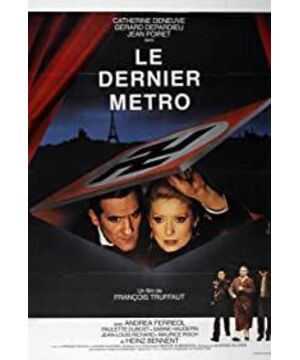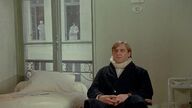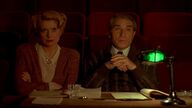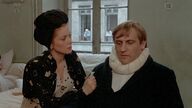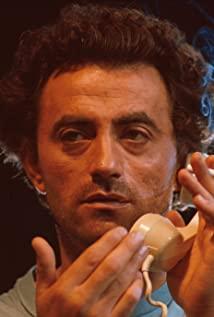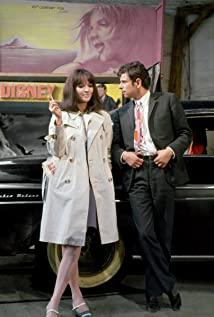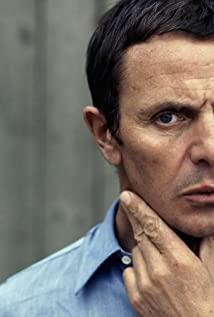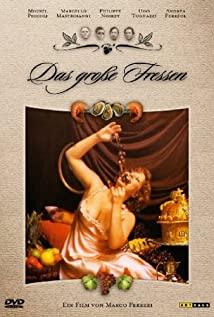If the form of the film is discussed, then this film is a complete "play in play" structure. Unlike "Day as Night", the characters are not closely related in and out of the play, and only the director Deeply "poisoned" by the progress of the movie, and the film in a dream, the emotional impact of the characters is only the departure of some people and the arrival of other people. The movie is still successfully completed. And in "The Last Subway", the feelings between Mrs. Steiner and Grange are expressed from the drama, from the inside out, and the emotional continuation lies in the drama "Stranger Woman". The three acts are " "Arrival", "Bad news" and "Affection", referring to the relationship between the two outside the theater is "Grange comes to the theater", "Grange punches Dachert", "Grange makes love to Katrin", and the drama is The ending of Dzogchen coincides with the ending of the movie. In fact, the opening and ending of the movie use red as the background color, which also implies the "opening" and "curtain call" of the movie as a drama, and as the narrator of the story, it can also be regarded as the highest of this drama movie. The narrator, the film itself is an original drama "storytelling", and the stage of "storytelling" is in the former Montmartre theater. Then, this film, as a product of the "drama" imagination, can completely be compared with the movie. The drama "Stranger Woman" formed a very neat confrontation, and "play in play" came out of it.
Although the setting of the film was set during the cruel World War II period, it can be seen that Truffau started from humanitarian care and did not severely criticize the Nazis or the French army. What he cared about was people under the general background. The status quo of existence, rather than armed and struggle. Compared with the setting of the role, the most involved environment is Grange. As a Jew, when he signed with the Montmartre Theatre, he was willing to give up his identity as a Jew. After a series of changes in the war, he was willing to give up his identity as a Jew. He left the Montmartre Theater and joined the struggle of the Resistance. The audience can naturally think that Grange made this choice as a "salvation" emotion of national sentiment, but from the time given by the movie background, It was the time when the Allied forces liberated Paris. You must know that the Germans occupied Paris for only four years, so Grange's behavior changed from the first half of the movie (the Germans attacked non-occupied areas) and the second half (the frequent air raid warnings). Whether to take the best action to himself as the battle situation changes is in line with his "prodigal son" attribute. Another interesting role is Dachet. As a drama critic, he has high accomplishments. This is reflected in his drama reviews and the discovery that "Stranger Woman" is a replica of Lucas. However, he is the Minister of Culture. , Is to carry out the Nazi's orders, to carry out a devastating blow to the Jews. Under such a mixture of the two identities, Dachet is very interesting as a clear villain in the movie. On the one hand, he is a film critic and his comments are cast aside by the theater. On the other hand, he is the mouthpiece of the Nazis. , Was spurned by the French. Under the double spurn, he could still regard it as invisible, just as he said, "He is a powerful man." At the same time, his love of art seems lovely, but for the Montmartre Theatre, this is not good news.
When it comes to the love of art, we have to mention the French at the time. No matter how difficult the environment they are in, they have to go to the theater to see the theater, which proves the phenomenon that Lucas assumed at the beginning of the film: the fact that the theater will close at a loss does not hold true, provided that the drama is good enough. Lucas is in the dark, painful, and self-doubt, but because of this, the best work is born. He didn't know that underage Jewish girls would watch his play regardless of danger. German military officers would take the lead and applaud his play. Dachert would promise to protect Lucas just to see a "decent play." . From this point of view, art has no national boundaries. As long as it is perfect art, it can gather people from all over the world who know how to appreciate art.
From a technical point of view, the red tone created by the whole movie is not only based on the curtain of the drama. The Nazis symbolizing killing are crimson, and the drama symbolizing love is pink. The light source is mostly warm light, low light, and respect. In fact, at the same time returning to the authenticity, it eliminates the conflict of the movie and caters to the beauty of life's trivialities. This may be an important reason for the dullness of the movie. But the work is also bold. Truffau starts from humanitarianism and breaks the imprisonment of morality. A woman has two men, and the plot of peaceful coexistence makes people feel incredible. At the same time, the homosexuality of the stage and the beauty of the French may be justified by the openness of France. From this. At the same time, the blur and ambiguity of the movie are very well used by Truffau. Most of the movies use a telephoto lens, resulting in a flat two-dimensional effect, which is in line with the dramatic form, and most of them use the middle shot method. It is also better to control the amount of information in a single lens to create the illusion of a narrow scene and focus on the inside of the theater instead of the world. Truffaut might think so. At the end of the film, Truffau played a trick, which made the narrative of the film and the narrative of the drama completely tied together, creating an illusion that the audience mistakenly believed that "drama is the reality of the film". But who can make it clear that the film with narrative and discussion at the beginning and end has no real connection with reality. The whole story is only a one-sided reflection of reality.
This is the only movie that did not break the "one woman and two men" triangle relationship. Truffaut’s "Occupy and Ancestor" was killed by two, Godard's "Outlaws" killed one, and In this work, three people hold hands. Grange represents the politics that moves in the wind, while Lucas represents the eternal art. In Truffaut's view, the two can be peaceful. Coexist, go hand in hand.
View more about The Last Metro reviews


